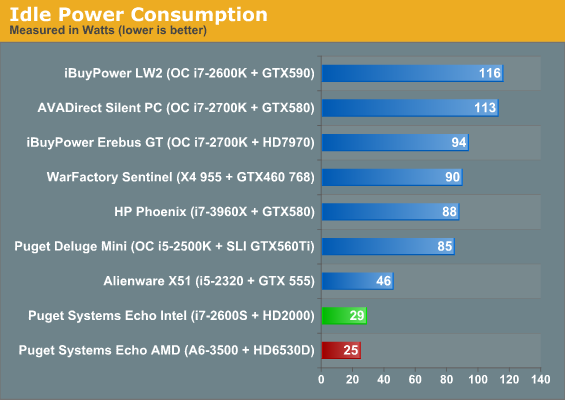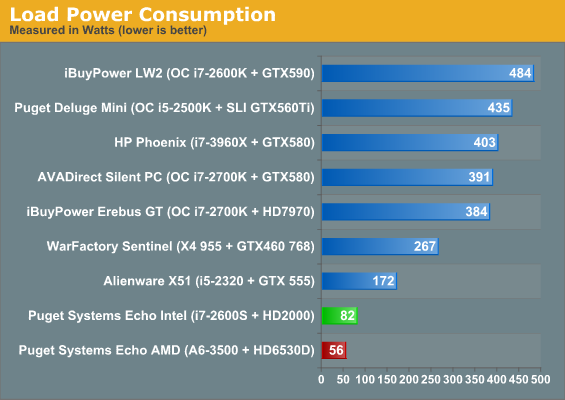Puget Systems Echo: Intel and AMD Showdown at 65 Watts
by Dustin Sklavos on March 21, 2012 2:35 AM EST- Posted in
- Systems
- AMD
- Intel
- Mini ITX
- Sandy Bridge
- Llano
- boutique
- Mini-Tower
Build Quality and Part Selection
Given the small nature of the Antec ISK-110 enclosures Puget Systems employs for their Echo I systems, it's not going to be much of a surprise that there's really only so much they can do to make build quality stand out. For what it's worth, the systems are put together as well as one can expect. Both use stock coolers from AMD and Intel, but given the low TDPs of the two processors (as well as the cramped confines of the enclosure) these coolers are never given much of a workout. Cabling is routed as well as can be expected, and Puget Systems filled both of the 2.5" drive bays. These systems really are packed to the gills.
.jpg)
This is a good time to bring up one of the ways Puget Systems distinguishes themselves from other boutiques, though. If you opt to configure a system on their site, you're going to find the number of available components substantially lower than you will from any other boutique. This has to do with their validation procedures; Puget is extremely picky about the parts they include in the desktops they ship and while I'd like to see this confidence reflected in a longer warranty than just one year, I've seen enough of their data (and their customer feedback) to corroborate their claims. It's the reason you only see Intel SSDs in their systems, for example.
It's also part of the reason why our AMD system is fighting a bit of an unfair fight, a point we brought up with Puget Systems and one they recognized. It's well known that Llano will use all the memory bandwidth it can get its hands on, while Sandy Bridge is much less sensitive. Puget hasn't qualified any 8GB DDR3-1600 DIMMs for deployment in any of their builds, and so they erred on memory capacity instead of speed. In conversations via e-mail, they even admitted this was probably a mistake in this instance. The problem is that they also don't offer any 2GB or 4GB DDR3-1600 DIMMs for the AMD-based system, either, when they do have 4GB DDR3-1600 DIMMs qualified for other builds.
As an aside, I did contact Puget Systems and ask why their parts warranty period was so limited compared to other boutiques, and their rationale is actually a fairly sound one: there's just no guarantee that the replacement parts will continue to be available for three years, given how fast hardware turns over in this industry. They don't feel a standard three year warranty is something they can in good conscience live up to, and so the three year warranty upgrade they offer is actually in place to cover the costs of offering brand new kit to replace defunct hardware should the need arise.
Heat and Noise
While I wasn't expecting too much in the way of thermal issues even with the stock cooling, I felt like noise could've gone either way when I pulled the two Echo systems out of their boxes. The side panel above the motherboard is completely ventilated, allowing fresh air to circulate inside the enclosure. That's great for cooling, but does absolutely nothing to muffle noise.
Thankfully, the circulating cool air does wonders to keep either heatsink's fan from having to work particularly hard. Neither system is actually audible while running unless you put your ear up to the open side; any kind of ambient noise in the room will muffle them. The result is that both systems never see temperatures above the low 60C on the cores, and noise is essentially a non-issue unless you're looking for a "silent" system.
Power Consumption
Most of the test results up to this point have been fairly predictable, but power consumption was a big surprise and a pretty stunning upset. Rather than build you up to it, I'll just show you.


At both idle and load, the AMD-based system beats the Intel-based one. Look at the load numbers in particular; the A6-3500 is able to beat the Intel Core i7-2600S by nearly thirty watts. I expected both to be frugal, but the A6-3500 is actually performing well under its rated wattage.


_thumb.jpg)
_thumb.jpg)
_thumb.jpg)
_thumb.jpg)
_thumb.jpg)
_thumb.jpg)








62 Comments
View All Comments
ggathagan - Wednesday, March 21, 2012 - link
As mentioned in the article:"Puget hasn't qualified any 8GB DDR3-1600 DIMMs for deployment in any of their builds, and so they erred on memory capacity instead of speed. In conversations via e-mail, they even admitted this was probably a mistake in this instance. The problem is that they also don't offer any 2GB or 4GB DDR3-1600 DIMMs for the AMD-based system, either, when they do have 4GB DDR3-1600 DIMMs qualified for other builds."
compcons - Wednesday, March 21, 2012 - link
Although I am not claiming a bias, it is a real shame you had to test that Llano with crappy 1333. Although I wouldn't recoomend rolling your own system to run in this silly race, I think it would be very enlightening to see how this would do with fast RAM (1800). I myself was really dissappointed after reading how crappy the AMD did in the CPU tests until I got to the end of the article and realized it was slow RAM. Not o be too harsh, but based on the price and poorly conceived system configuration, I'd tend to not buy anything form these guys...EH
JKflipflop98 - Monday, March 26, 2012 - link
I would be very interested in a future update to the article testing if swapping out the memory modules actually do make that big of a difference.There's only one way to find out. . .
Andrew.a.cunningham - Wednesday, March 21, 2012 - link
Ditto on my end. These endless accusations of bias and/or corruption devalue hours of work on the part of writers and prevents the reasonable discussions that AT commenters are more than capable of having.Andrew.a.cunningham - Wednesday, March 21, 2012 - link
...and these comments are on an article that actually recommends the AMD system over Intel's. :-)ImSpartacus - Wednesday, March 21, 2012 - link
While I cannot disagree with the content of this post, might I suggest that Anandtech staff not respond to critical (errr trolling) comments?I come to Anandtech for a cold and completely objective look at the consumer technology of today and tomorrow.
Sometimes, it isn't possible to hold an objective discussion with commenters. Impassioned (albeit respectful and 'correct') comments can slowly damage the image of a journalist and their distribution channel.
If this site starts falling apart, I won't have anywhere to go. Can we nip this in the bud?
Tchamber - Wednesday, March 21, 2012 - link
Availablility is the issue, they even mentioned that in the article. What mainstream, trusted website were you going to pick that 65w A6 3600 at?BSMonitor - Wednesday, March 21, 2012 - link
Clearly Puget is going for two different market segments with each system. It makes perfect sense to me.The Core i7-2600S is $100 more expensive than the Intel Core i5-2405S, but comes with half the graphics computing power. They simple chose the best CPU performance they could fit in 65W. It would make no sense to have two identical product lines with the only difference for the customer to choose AMD or Intel. So the AMD side is left for the best iGPU performance at hand.
On one line, they are going for low end gaming. On the other, raw computing power. Intel vs AMD is superficial to them. With the mini-gaming rig they also make more $$ as the APU costs $150-70 less.
And please, don't make me laugh.. You could dump 20 Llano cores into the thing and it wouldn't touch Sandy Bridge quad cores. Grow up.
jgutz20 - Wednesday, March 21, 2012 - link
That is true about the AMD cpu used is far from its best, And while the AMD chip has the best GPU of the 2, I'd like to see a "slower" intel chip, be it a i3 or an i5, whatever they have within power envelope that has the HD3000 graphics as that would even the playing field a bit more.I guess what i would like to see is Anandtech re-doing this comparison but with their own build so as to ensure they get the best parts available, not the best parts this company offers in this form factor. Get the MB/CPU/RAM for each setup and re-use the case, HDD's etc.
That is what i would like to see as a follow up to this article!
medi01 - Wednesday, March 21, 2012 - link
At least they couldn't test low power AMD CPU with 1000 watt PSU this time, lol...PS
1500$ for these, you must be kidding me...